How to Start a Developer Newsletter
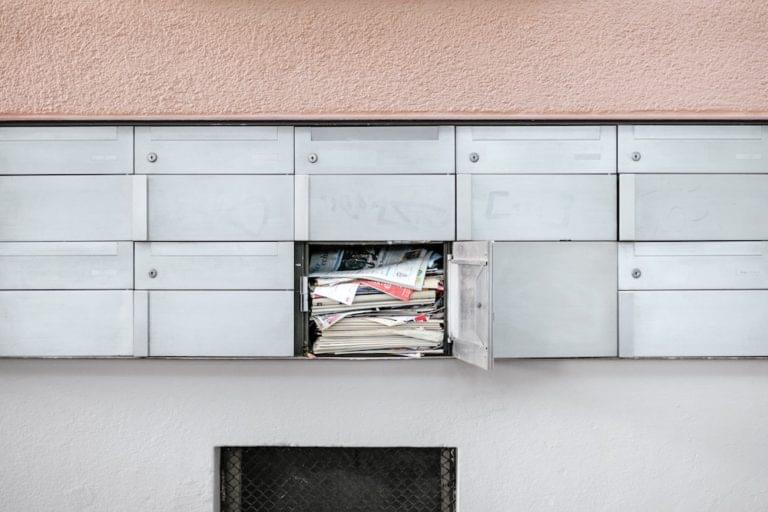
Developing software has become a collaborative effort. Many development platforms are open source. Developers share libraries on GitHub. And there are huge communities for knowledge sharing, like StackExchange.
While most developers hate email, a developer newsletter can be a great way to share knowledge, be visible in the community and establish yourself as an expert.
A carefully curated newsletter full of useful tips and other content is not the type of email that people hate. Rather than being a distraction, it can be a great time-saver and help readers avoid missing any useful content.
But how do you get started?
Key Takeaways
- Starting a developer newsletter can be a great way to share knowledge, increase visibility in the community, and establish oneself as an expert. It should be high in quality and authentic, focusing on a niche topic the author is passionate about and knowledgeable in.
- Consistency is key for a successful newsletter. It should be sent regularly to set expectations with readers and fit their reading habits. The newsletter should be sent in the author’s own name to create trust and encourage person-to-person communication.
- Promotion of the newsletter should be done carefully and in the right places where the chosen topic is discussed. Feedback from readers should be encouraged to maintain an open communication channel and improve the content.
- The right platform for writing and sending the newsletter should be chosen, with requirements such as a productive authoring tool, a beautiful, out-of-the-box template, and easy integration with contacts and content sources.
Learn from the Best
A good way to get started is to subscribe to some well-done developer newsletters and learn by watching what their authors do.
An instructive example is Ruby Weekly, which was started back in 2010 and today is at an almost unbelievable issue #358.
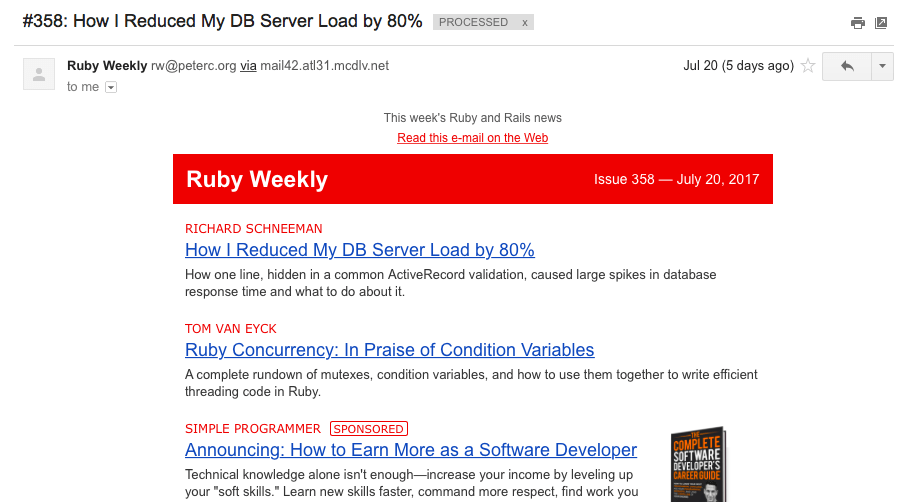
What we admire about this newsletter is its consistency. It’s sent every Thursday and has been sent on that very same day for years and years. This is a great way for readers to know what to expect and when. Its layout is simple and no frills. And the articles shared are strictly on topic every week.
A very different, but also very interesting example is Versioning by this article’s publisher, SitePoint itself.

It covers a broader array of topics, and is sent on a daily basis. It’s early morning reading to make sure you’re briefed on the best in front-end, back-end, UX and design, business and wacky tech news, to start your day.
What we like is its personality. It’s personally curated by SitePoint’s Head of Content, Adam Roberts, and spiced up with his own sarcastic humor and plenty of puns.
Another tech newsletter we like a lot is Vue-newsletter. We really admire the laser focus on just a single JavaScript framework.
The result of this focus is a very comprehensive newsletter. Each edition provides a good overview of everything that has happened in the Vue.js community in the previous week. It becomes essential reading and a perfect one-stop shop.
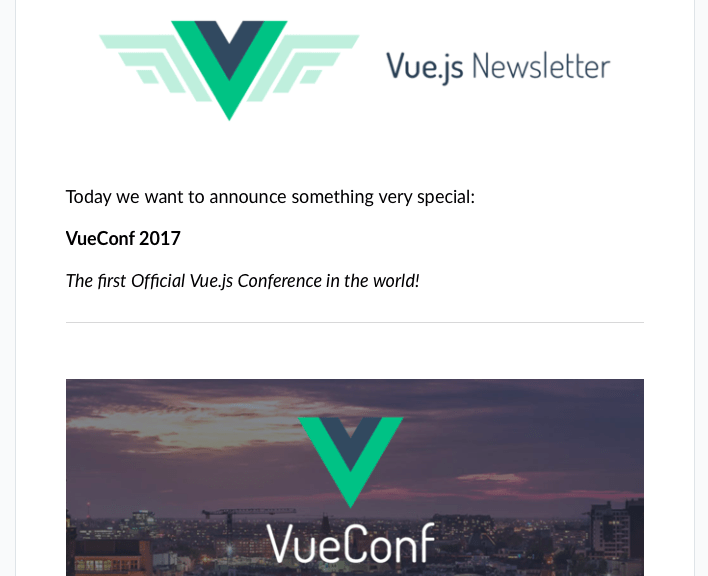
A final example is the Fullweb newsletter, a newsletter for full-stack web developers.
It, too, really has personality, but very much uses design to achieve this. And again, its format is very consistent, sharing the five best links of the week, every week.
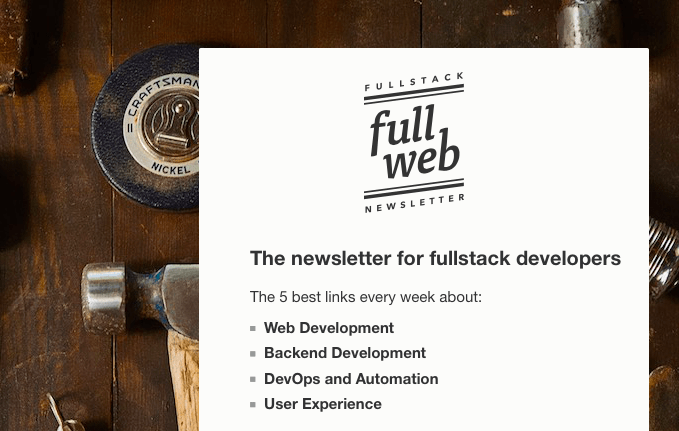
Subscribing to a few newsletters is the perfect way to get started. It will provide you with plenty of examples of what others do, and help you figure out what works and what doesn’t.
We hope that our favorites are a good start. To find more great developer newsletters see the tech section on Revue’s newsletter directory, Discover.
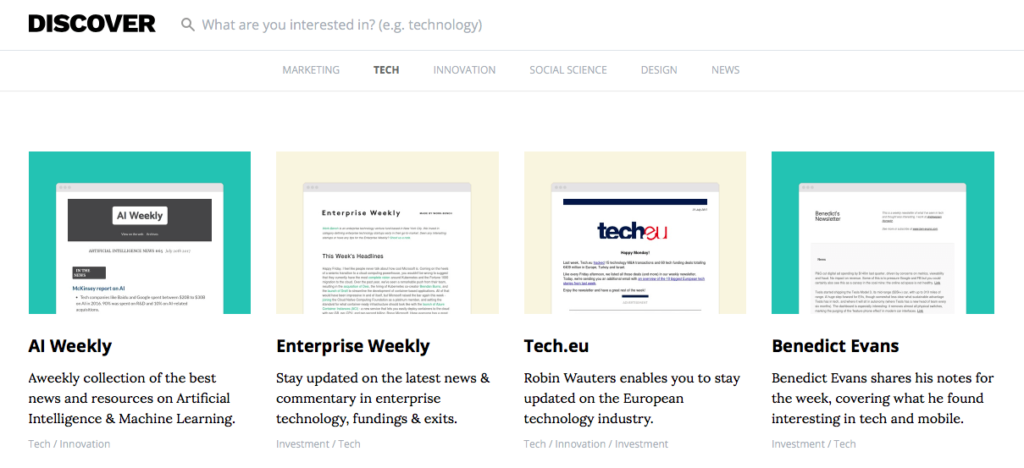
Follow These Newsletter Best Practices
We’ve looked at some great developer newsletters. Are you ready to start your own? Then we have these best practices for you to provide some additional guidance.
Pick a niche that you are passionate about, and an expert in
The newsletter needs to be high in quality and authentic. You will only succeed at that if you are very involved with the topic.
The broader the topic you choose, the harder success will be. There will be more competition on general topics than a well-chosen, still-neglected niche. People in a niche will be glad to receive highly targeted news, and will quickly recognize and appreciate your expertise.
Send in your own name
Sending a newsletter in your own name creates trust. Readers will open and read the newsletter because they recognize the sender.
Adam sends Versioning, Kevin Rose sends his Journal, and Boris sends The Next Web’s newsletter…
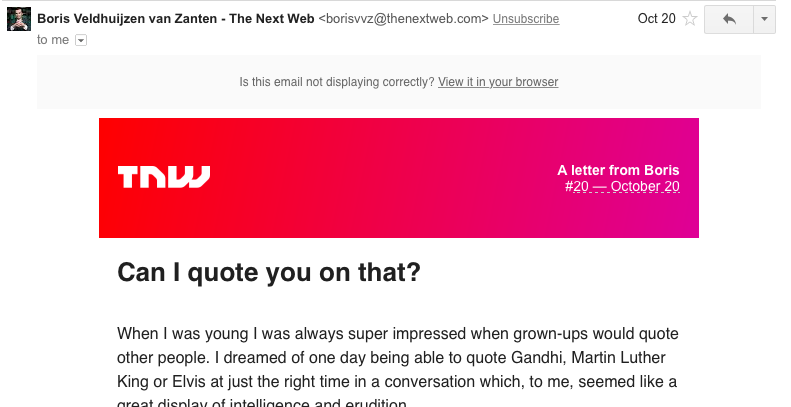
It’s email. It’s person-to-person communication. And it’ll be much more effective if used accordingly.
Send regularly
There are different frequencies for newsletters — daily, weekly, bi-weekly, monthly, quarterly. While the right frequency depends on the topic and also on the author, it’s still important to send the newsletter regularly.
This will set expectations with readers and help them decide whether the newsletter fits their reading habits.
Benedict Evans, partner at venture capital firm a16z, has sent his personal newsletter every Sunday for years. And the results are impressive:
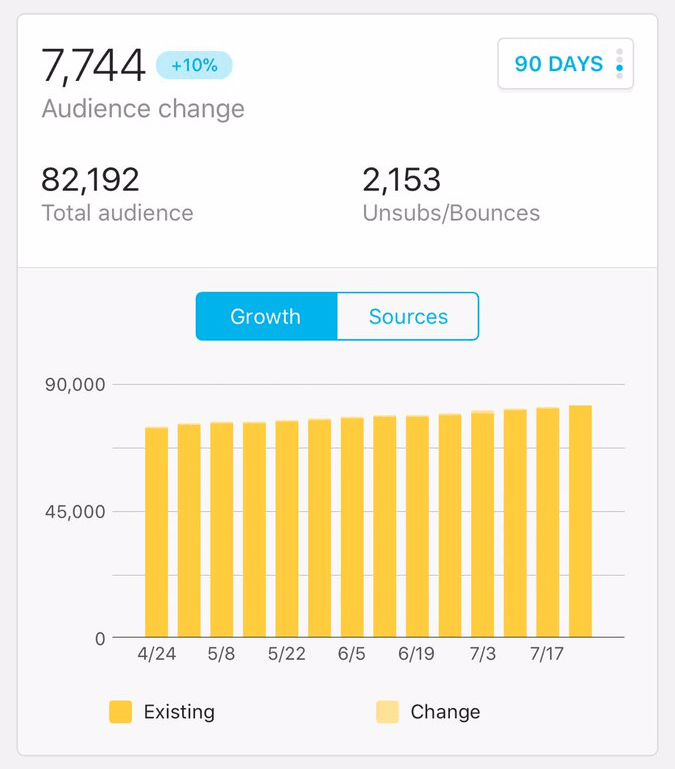
Don’t worry about subscribers too much – get started
The people you hear about are often influencers or public figures with astronomical numbers of followers or subscribers. Don’t forget that while they are the ones you hear about, they are a minority. Reaching the right audience is much more important than reaching a large audience.
And you know what is best? Once you have identified the right audience and reached them, you can be pretty sure your subscriber numbers will go up. Just make sure your subscribers are happy and ask them to share the love.
Promote your newsletter in the right places
If you have picked your topic carefully and chosen a specific niche, you should look for other places where this topic is discussed and carefully promote your newsletter there.
You need to follow local etiquette, but being on topic should assure you that your newsletter is a welcome addition.
The React Digest reached out to Y Combinator’s Hacker News. They received 83 points and 21 comments, which meant their number of subscribers went up from about 20 to several hundred.

Ask for feedback
Email is, and always has been, two-way communication — yet many promotional newsletters have very much become one-way streets sent from “do-not-reply@merchant.com” email addresses. A developer newsletter should be an open communication channel.
So dare to ask your readers to give feedback. Ask them questions about different elements of the newsletter, or simply how they’re liking it.
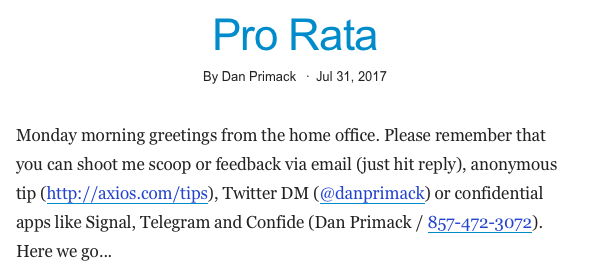
Establish ways of finding the right content
We recommend collecting interesting topics and links constantly, and then setting aside a certain time of the day to curate those links and write your personal newsletter. So what’s a good way to come up with new topics?
Chime in on current events: the topic is often something current like a hot news item or conference or other event. You will usually want to start with your personal take, and then build out the content by curating other perspectives, in-depth background articles or other related content.
Re-purpose your own channels: Content can come from your own channels, i.e. you can send out a personal newsletter around a popular blog or Facebook post.
Follow other blogs and newsletters: Make sure to regularly visit blogs and publications you find interesting. The content you find there can later be used as basis for your thoughts on your issues.
Use Pocket or the Revue Chrome extension: Another way to collect content for your newsletter is to save interesting articles while browsing the Internet. During the day you are reading multiple articles that you can easily save using tools like Pocket or the Revue Chrome extension.
Have an opinion
It’s a personal newsletter and people want to know what you think.
Since news travels fast, chances are people have already read about what happened somewhere else. So refrain from just repeating old news and instead say what you have to say.
Technologist Owen Williams does a great job at this with his weekly tech newsletter Charged. He sends it out every weekend, looks back at the most important events of the week, comments on them and provides his personal opinion.
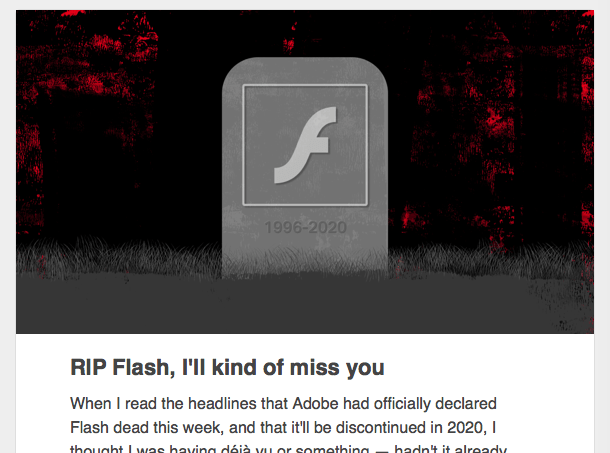
Pick the right platform for writing and sending
There are many tools you can use to send your personal newsletter. Your regular email client might be enough to get started, and promotional newsletter tools can be customized given enough time and resources.
An even better option is a specialized tool that makes it quick and easy to get started while assuring you to get that coveted personal note.
So what are the requirements of a tool for authoring personal newsletters?
Productive authoring tool: You need an authoring environment that makes you want to write. It should give you focus to pen those personal stories. And it should help you pull in content that you or others have shared previously using drag-and-drop.
Beautiful, out-of-the-box template: Your personal newsletter should look great and have that intimate, text-focused style without you having to become a designer or programmer.
Integrations: The personal newsletter tool needs to integrate easily with contacts and content sources. There’s probably quite a long list of content sources, so flexibility is key here. Adding contacts from your personal address book, a promotional newsletter tool, or CRM system is also a must.
And while we realize we are biased, we do want to suggest you check out Revue, which was specifically designed for personal newsletters.
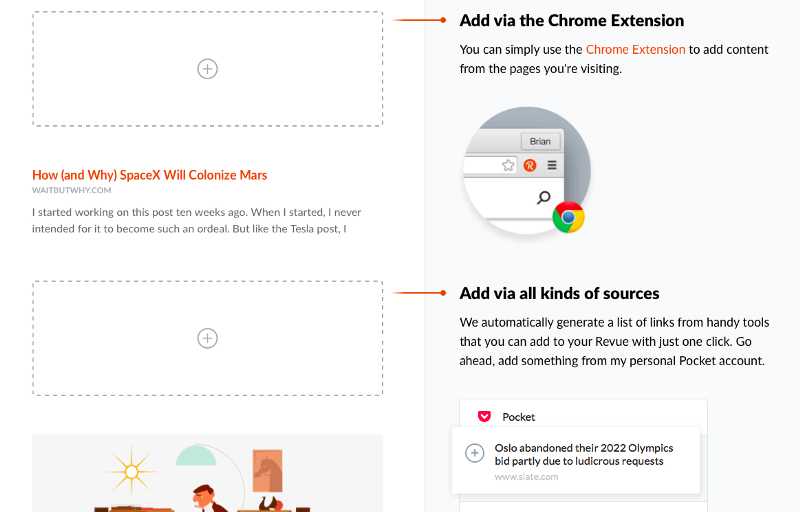
Frequently Asked Questions (FAQs) about Starting a Developer Newsletter
What are the key elements to include in a developer newsletter?
A developer newsletter should include a variety of content to engage your audience. This can include coding tips and tricks, industry news, updates on your projects, and resources for further learning. It’s also important to include a personal touch, such as a brief introduction or a note about your recent activities. This helps to build a connection with your readers and makes your newsletter more engaging.
How often should I send out my developer newsletter?
The frequency of your newsletter depends on your content and your audience’s preferences. Some developers send out weekly newsletters, while others opt for a monthly schedule. It’s important to maintain a consistent schedule so your readers know when to expect your newsletter. You can also ask your subscribers for their preferences to ensure you’re meeting their needs.
How can I grow my subscriber list for my developer newsletter?
Growing your subscriber list requires a combination of strategies. You can promote your newsletter on your website, blog, and social media channels. You can also offer incentives for signing up, such as exclusive content or early access to new projects. Additionally, providing high-quality, valuable content will encourage your current subscribers to share your newsletter with others.
How can I make my developer newsletter stand out?
To make your newsletter stand out, focus on providing unique, high-quality content that your audience can’t find anywhere else. This could include in-depth tutorials, personal insights into the industry, or exclusive interviews with other developers. Additionally, a clean, professional design can help your newsletter stand out and make it easier for your readers to engage with your content.
How can I measure the success of my developer newsletter?
There are several metrics you can use to measure the success of your newsletter. This includes the number of subscribers, open rates, click-through rates, and feedback from your readers. You can also look at the growth of your subscriber list over time and the number of shares on social media.
How can I monetize my developer newsletter?
There are several ways to monetize your newsletter. You can include sponsored content or advertisements, offer premium content for a fee, or use your newsletter to promote your own products or services. It’s important to balance monetization with providing value to your readers to maintain their trust and engagement.
What are some common mistakes to avoid when starting a developer newsletter?
Some common mistakes include not having a clear focus for your newsletter, not maintaining a consistent schedule, and not engaging with your readers. It’s also important to avoid overly promotional content and to always provide value to your readers.
How can I ensure my developer newsletter is accessible to all readers?
To ensure your newsletter is accessible, use clear, simple language and a readable font size. Include alt text for images and ensure your design is compatible with screen readers. You can also provide a text-only version of your newsletter for those who prefer it.
How can I handle feedback and criticism of my developer newsletter?
It’s important to be open to feedback and criticism and to use it to improve your newsletter. Respond to feedback in a respectful and professional manner, and make changes based on your readers’ suggestions when appropriate.
How can I keep my content fresh and engaging for my developer newsletter?
To keep your content fresh and engaging, stay up-to-date with the latest industry news and trends. You can also ask your readers for their input on what topics they’re interested in. Additionally, experimenting with different types of content, such as videos or interactive quizzes, can help keep your newsletter interesting.
Metrics, product and growth for startups. Interim CTO. Tech due diligence. Currently at Fitmo, HousingAnywhere and Revue.



